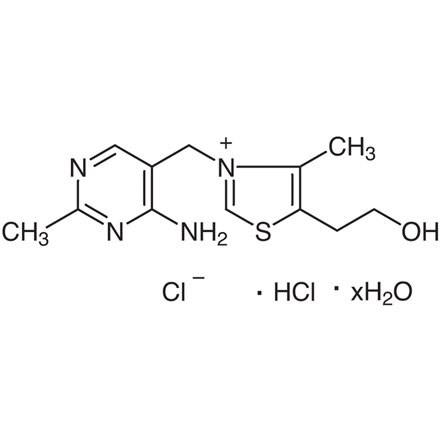APPLICATION
Thiamine (Vitamin B1): One of Essential B Vitamins with Many Important Functions in All Tissues
Thiamine, also known as vitamin B1, is one of essential B vitamins that has many important functions in all tissues.1-3) Two types of water soluble thiamine salts, thiamine hydrochloride [T0181] and thiamine nitrate [T0182], are commonly used to products.4) Thiamine pyrophosphate (diphosphate) chloride [T0183] is the biologically active form of thiamine. In addition, thiamine hydrochloride is also used as an efficient catalyst for chemical reactions.7,8) For your reference, [A2633] is a key synthetic intermediate of thiamin. (The product is for research purpose only.)
Synthesis of Formamide Derivatives Catalyzed by Vitamin B1 Hydrochloride
N-Formination of aniline using VB1 as a catalyst:
A mixture of aniline (5 mmol), formic acid (1 mL), and VB1 (0.1 mmol, 2 mol%) is heated at 80 °C under stirring for 10 minutes. After completion of the reaction as indicated by TLC, 20 mL of EtOAc is added and washed with 5% HCl aq., 5% Na2CO3 aq., and brine. Then, the organic layer is dried over MgSO4 and concentrated to afford N-formylaniline in 96% yield without further purification.
Thiamine Catalyzed Benzoin Condensation: Synthesis of Fluorobenzoins
Typical procedure : Synthesis of 4,4’-Difluorobenzoin
1,2-Bis(4-fluorophenyl)-2-hydroxyethanone is synthesized by condensation of 4-fluorobenzaldehyde (5.0 g, 40 mmol) in the presence of thiamine hydrochloride (0.67 g, 2.0 mmol) and sodium hydroxide (0.20 g, 5.0 mmol) in ethanol. The reaction is carried out at 50°C for 48 h and then the mixture is cooling on ice. A formed crude product is filtered and washed with ice cold 75% ethanol. The material is recrystallized from ethanol to give white crystals in 75% yield.
QUALITY CERTIFICATION / COMPLIANCE
Fukaya factory is certified for GMP, ISO14001:2004 (JQA-EM5386) and IQ Net (JP-JQA-EM5386).


